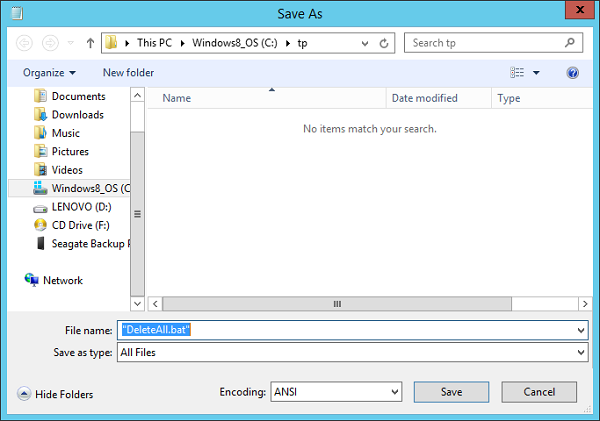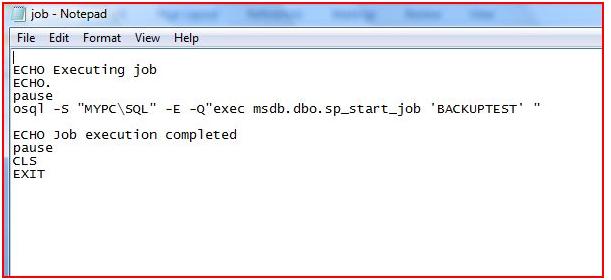

- Sql batch script example how to#
- Sql batch script example full#
- Sql batch script example code#
- Sql batch script example windows#
Since you said the database is remote, use the following syntax (after updating for your server and database instance name). Then use sqlcmd to execute it as follows. SQL file, ex: ClearTables.sql, say in your C:\temp folder.Ĭontents of C:\Temp\ClearTables.sql Delete from TableA The script writes a few preliminaries to the SQL File that will eventually be executed.Save the commands in a. With this list, it creates a SQLCMD script that writes out the results for each table to a different file in the directory you designate. The script contacts the database to get a list of tables in the database you wish to use, and gets a list of the schemas and tablenames as a tablespec. This is not that good, but a lot better that embedding UserIds or passwords in a script. The script stores the credentials in plain text in the user area, relying on NTFS security to prevent them being disclosed.

No teardown is needed because the temporary procedures are deleted along with temporary tables when the connection is closed. I use the technique by loading all or any of the procedures I need at the start of the sqlcmd script and the procedures remain throughout the script because everything is run in the same connection. I’ve mentioned these in a previous article. You will need the MSDN instructions on SQLCMD with you as you work.
Sql batch script example full#
The most important advice that MSDN gives is to do as much as possible in a single SQLCMD session, and make full use of the sqlcmd commands, many of which work in SSMSs SQLCMD mode. The SQLCMD command-line executable is a wonderful tool, but you really need to use it frequently in order to remember all the important switches, Command-line Options, scripting variables and sqlcmd commands. Someone has even written Adventure games, RPGs and 3-D modelling in DOS Batch scripts: not because it is wise, but because it is challenging and invigorating to do so SQLCMD Stack Overflow is full of helpful Q&A pieces. Plenty of grey-muzzle ops people have built up expertise with DOS shell batches and see no reason to change, or to convert their myriad scripts.
Sql batch script example windows#
There are plenty of DOS script archives, and a package manager for Windows Batch scripts written, of course, as a batch file. The old MSDOS Batch news groups are still active.
Sql batch script example code#
On the Rosetta Code site, DOS Batch File Scripts compete with other languages for solving computer tasks and problems. To read the full story, type, in the command shell the names of all the commands followed by /?Īgainst all expectations, DOS scripting has thrived. If you don’t break into a sweat, you’re not reading it properly. If you have any sense that I’m exaggerating, just read the excellent documentation built into the command shell.

The problem with Batch Files is that the format has been evolved over time by MSDOS/Windows developers who have little in the way of an overall vision of how a scripting language should work, so now it is a mess of switches, cryptic punctuation, strange conventions and hacks. Batch files were supposed to be superseded by PowerShell. It has evolved from the batch script language of MS-DOS, COMMAND.EXE, and CMD.EXE. Dos Batch scriptsīatch files are written in the scripting language for Microsoft command line shell. Dos Batch Scripts, SQLCMD scripting and the use of Temporary Procedures in SQL Server. In this script, I’m combining three slightly unconventional techniques. In looking around to find out if anyone had done a similar job, I was surprised to find very little, and even read some comments on forums that it couldn’t be done: So I wrote this article. Sadly, I have considerable ‘previous’ with writing DOS and Windows Batch files, as it was, and still is, the equivalent to Duct Tape, Cable-ties and superglue for working with Windows servers. I therefore went back to my roots and did it as an old-fashioned batch file, command file, call it what you will. The MongoImport utility didn’t want to play nicely with PowerShell, which is any Windows developer’s preferred way of scripting. I originally did this because I had to write a utility for copying a SQL Server database to MongoDB. With tweaking, it will do XML or tab-delimited output as well. Just to make it a bit harder, I’m doing it in extended JSON (MongoDB format), but I’ve included access to files with procedures for doing it in ordinary JSON or array-in-array JSON.

Sql batch script example how to#
It shows how to use temporary stored procedures to advantage. This article is about using the DOS Batch script facility of the Windows command line, together with SQLCMD to write the contents of each table in a database to the local filesystem. Using Batch Scripts, and SQLCMD to Write Out a Database's Data.


 0 kommentar(er)
0 kommentar(er)
